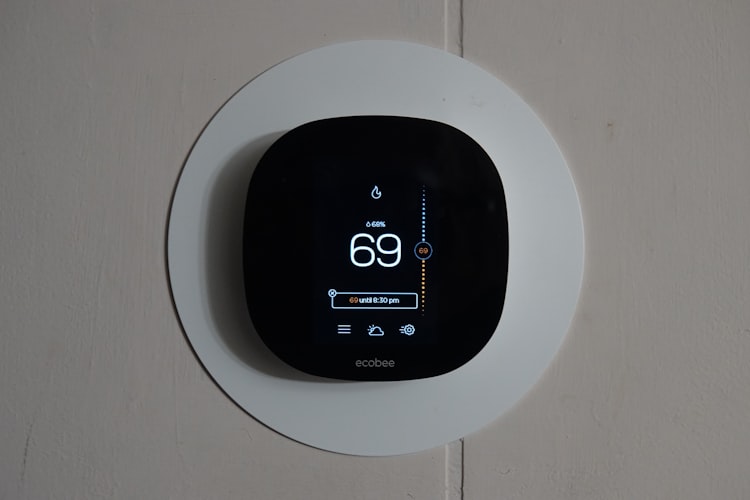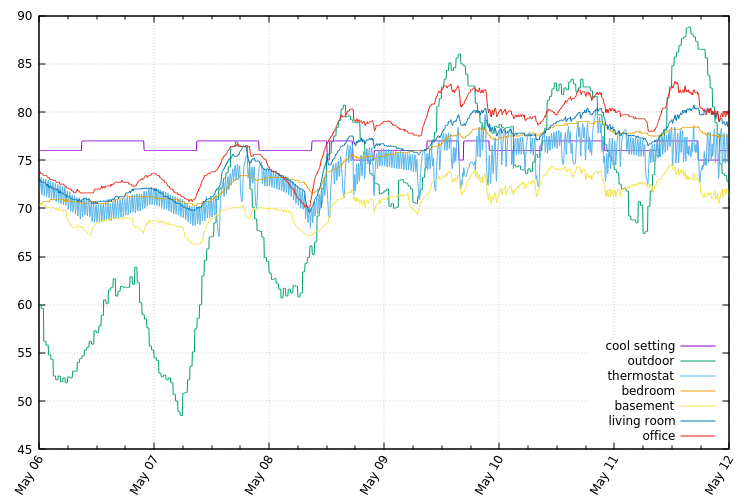Smart Thermostat

Here at Baker’s Acre, we jumped on the smart internet-connected thermostat bandwagon with the first Nest thermostat in 2011. It was fantastic!
We loved the round dial and it just looked so intuitive and clean. It had the ability to learn our family’s schedule by using internal sensors to figure out when we were home. We could set the temperature from our phones. It could cool or heat our house before we arrived. It could estimate how long it would take to achieve a certain temperature in our house with our HVAC equipment, based on experience.
All of that was super neat, but was it worth the $200 price tag? Were we saving enough money to return the investment?
To be honest, I didn’t care. I even upgraded to the second generation model without thinking. But after a while, I noticed that we weren’t really using all the cool features anymore. Maybe we could live without it? Here is how I broke it down for us and where we have landed today.
What is Smart?
The way I see it, there are three degrees (hehe) of thermostat smartness:
- Mechanical - simple mercury switch style thermostats will keep your home at a set temperature with no problems at all; the genius is in the simplicity; no batteries are necessary.
- Programmable - most digital thermostats today let you plan for heat and cool separately and you can set different schedules; cheap ones will just let you program weekday/weekend, but most will let you schedule seven days a week; these often require batteries and have LCD displays.
- Smart - internet-connected thermostats have apps for your phone and lots of sensors and algorithms to learn how your home works and make the most out of your HVAC equipment; some even support remote temperature sensors for your rooms and can understand local weather conditions.
Today, most smart thermostats will also integrate with smart assistants like Google Home, Amazon Alexa, and Apple HomeKit. You can control them with your voice!
What is Important to Us?
For us, the important features boiled down to four things:
- No batteries. We didn’t want to be replacing batteries. Non-negotiable.
- Remote control. We want to set away-mode when we leave on road trips, and check in on system status while away.
- Room sensors. We want to keep specific rooms comfortable.
- Data analysis. We want to know how we are doing on energy usage month over month and compared to others in our area.
What is Not Important to Us?
- Learning algorithms. We already know our schedule. We don’t need it to learn what we already know.
- Personal assistant integration. We don’t really care for big tech listening to our conversations all day; we don’t use any smart assistants in our home.
What are we Using Today?
While we still adore the Nest, we started looking for alternatives after Google acquired the company. (In our opinion, Google is the least privacy-minded of all big tech companies and we try to keep a low profile, within reason.)
Currently, we are using the Ecobee 3 Lite. You might be able to get a rebate from your energy company to reduce your cost on this little gem. It doesn’t have enough smarts to detect if you are home but it supports room sensors; it charges itself from your HVAC’s wires, so no batteries; and it has all the scheduling goodies you would expect from any self-respecting smart thermostat.

What I really like, though, is the monthly reports from Ecobee about how we are doing on energy saving. And the nerd inside loves that I can download raw data to play with. Because of this, I was able to figure out why our HVAC unit was cycling so frequently and analyze the effect of a fireplace on our cold nights.

How do we Save Money?
Having a smart thermostat isn’t a magic solution. It won’t save you much money out of the box. You might get some small savings from the learning algorithms if you use them; this could help you keep your HVAC off when you are not at home if you are too busy to manage it yourself.
For us, the unexpected benefit is that we have become more aware of how we are heating and cooling our home. We use the app on our phones; we get alerts and make adjustments.
With this new focus, the big savings come in controling energy usage. You can save about 2% of your energy bill if you lower your heating or raise your cooling target by 2 degrees F for 8 hours. It doesn’t sound like a lot, but it adds up if you can take some big swings. For example:
- If you are out of the house for work all day, and drop your heating temperature by 11 degrees, you could save 12% on your bill.
- If you add a blanket to your bed and sleep 7 degrees cooler for 6 hours a night in the winter; this could save you another 6%. Now you’re talking 18% lower heating bills.
Here are a few more energy saving tips we love:
- Pay attention to the weather. We open our windows on cool nights in the summer. We turn the system off when the forecast looks comfortable.
- Add some blown-in insulation to the attic space. Depending on your climate, and for older construction homes, this is relatively cheap and it made a huge difference for us. You can even do it yourself with some rental equipment from your local hardware store.
- Consider heating or cooling some spaces independently. Use a small window AC unit for a poorly insulated space in the summer, but only when occupied. Install a mini-split unit in a room where your home’s ductwork services the room poorly.
Have some tips of your own? Drop us a comment below!